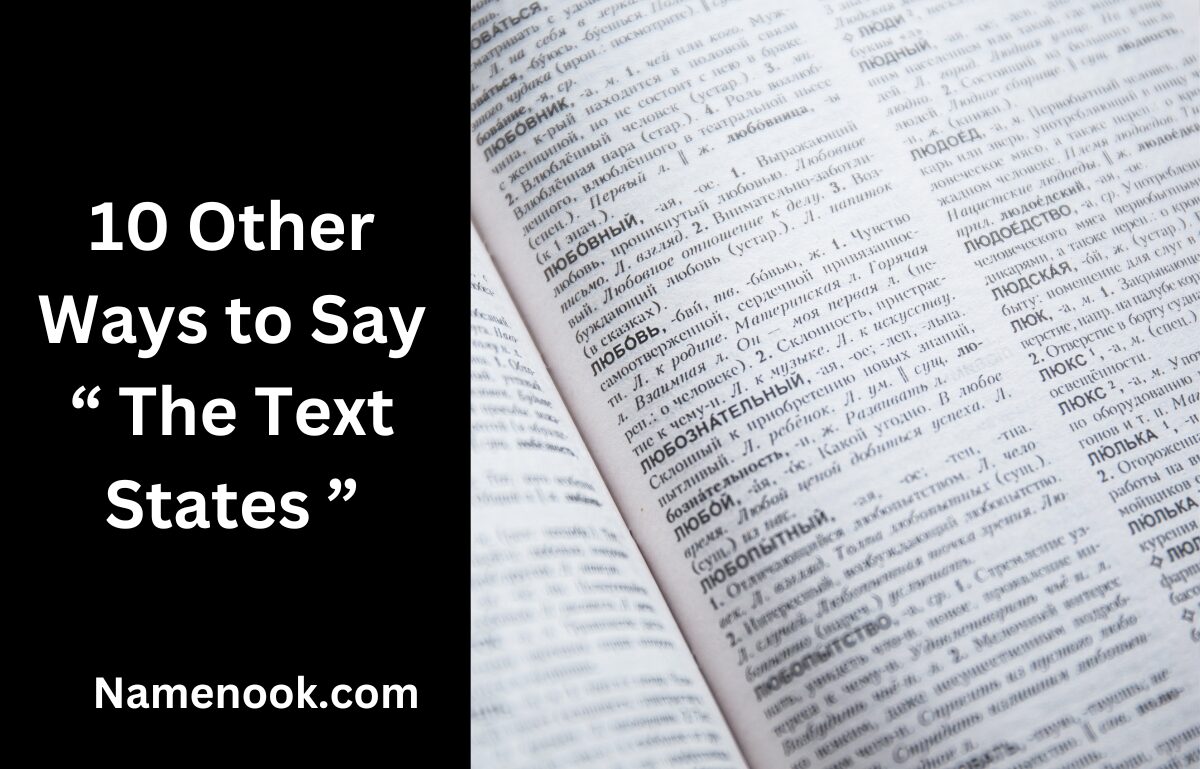When writing about a text or analyzing a reading, it’s easy to fall into the habit of using the same phrases repeatedly—especially “the text states.” While this isn’t necessarily incorrect, it can make your writing feel dull and repetitive.
To keep your work engaging, try using a variety of expressions when introducing evidence or quotes. This not only makes your writing more interesting but also helps you convey ideas more effectively.
In this article, I’ll share alternative ways to say “the text states” and provide examples for each, so you can see how they work in context.

Whether you’re writing an essay for school or discussing a book in a literature group, these alternatives to “the text states” will help you introduce quotes in a more natural and engaging way.
Is It Professional to Say “the Text States”?
No, overusing the phrase “the text states” in academic writing isn’t considered professional. While it’s clear and direct for introducing quotes or evidence, relying on it too often can make your writing feel repetitive and less refined.
A more polished and engaging approach in academic writing is to use a variety of phrases to introduce quotes and references. Instead of repeatedly saying “the text states,” try alternatives like “according to the author” or “as the passage indicates.” These variations not only enhance the flow of your writing but also demonstrate more advanced writing skills.
Using diverse language keeps your reader engaged and prevents your analysis from feeling monotonous. While it’s perfectly fine to use “the text states” occasionally for clarity, strong academic writing benefits from varied sentence structures and vocabulary. This allows you to present your ideas smoothly and effectively.
To make your writing more professional and polished, mix up your phrasing when integrating textual evidence. Here’s an example of a passage that overuses “the text states”:
Example of Repetitive Writing:
“In the passage about sea turtles, the text states that these creatures have existed for over 100 million years. The text states that sea turtles migrate long distances between feeding grounds and the beaches where they nest. The text states that sea turtles face many threats from humans, including pollution, habitat loss, and hunting. The text states that six of the seven sea turtle species are classified as vulnerable, endangered, or critically endangered.”
Pros of Using “The Text States”
✔ Clearly attributes information to the source.
✔ Provides consistency when introducing quotes and evidence.
However, varying your phrasing makes your writing more engaging and professional. By incorporating different ways to introduce textual evidence, you’ll create a more dynamic and thoughtful analysis.
Cons:
- Repeating “the text states” makes the writing feel monotonous and lacking in sophistication.
- The overuse of the same phrase structure creates a boring, rigid flow, making the writing feel less engaging.
What to Say Instead of “the text states”
Alternatives to “The Text States”
Here are some varied ways to introduce quotes or references from a text:
- The document asserts
- The passage claims
- The article articulates
- The writing specifies
- The section mentions
- The manuscript declares
- The narrative describes
- The content reveals
- The excerpt indicates
- The piece conveys
1. The Document Asserts
“The document asserts” is a formal way to convey that the text makes a clear and confident statement or position on a topic. This phrase suggests authority and is particularly useful in academic or professional writing when referencing official reports, research, or authoritative sources.
Example:
In her groundbreaking research on climate change, the document asserts that global temperatures have risen by 1.5 degrees Celsius over the past century, underscoring the urgent need for action.
2. The Passage Claims
“The passage claims” is often used when a specific section of a text presents an argument or statement that may be open to interpretation or debate. It subtly hints at the possibility that the claim could be challenged or further explored.
Example:
The passage claims that social media has a profound impact on shaping public opinion, though its effects are still widely debated.
This phrase is particularly useful when discussing literary works, essays, or articles that present a specific viewpoint or hypothesis.
Example:
In the debate on renewable energy, the passage claims that solar power could potentially meet the world’s energy needs, emphasizing the importance of investing in solar technology.
3. The Article Articulates
“The article articulates” suggests that the writing clearly and effectively expresses an idea, opinion, or fact. This phrase is perfect for discussing well-written articles that present their points persuasively and logically.
Example:
The article articulates the need for more inclusive workplace policies, arguing that diversity and inclusion are not only moral imperatives but also key drivers of innovation.
4. The Writing Specifies
“The writing specifies” is used when the text provides clear and precise information or instructions. It’s especially relevant in technical writing, legal documents, or any context where accuracy and clarity are critical.
Example:
In the instruction manual, the writing specifies the exact steps to safely operate the machinery, ensuring users can follow the procedures without confusion.
5. The Section Mentions
“The section mentions” is a more casual way to refer to a part of the text that briefly touches on or acknowledges a piece of information without going into too much detail. This phrase is useful for pointing out where a topic or idea is introduced in a broader context.
Example:
In the discussion on sustainable agriculture, the section mentions the role of organic farming in promoting soil health and biodiversity, though it doesn’t explore the topic in depth.
6. The Manuscript Declares
“The manuscript declares” implies a formal, somewhat grandiose statement or declaration within a document. It’s often used when referring to important findings or proclamations in scholarly or literary works.
Example:
The manuscript declares that the discovery of the ancient manuscript sheds new light on historical events, offering insights that were previously unknown.
Example:
In his latest novel, the manuscript declares the protagonist’s unwavering resolve to overcome adversity, setting the stage for a dramatic narrative of resilience and determination.
7. The Narrative Describes
“The narrative describes” implies that the story provides detailed descriptions, offering vivid imagery or thorough explanations of events, settings, or characters. This phrase is especially useful in literary analysis or discussions about storytelling.
Example:
The narrative describes the bustling streets of Paris in the 1920s with such detail that readers feel as though they are walking alongside the characters, experiencing the city’s vibrant culture and energy.
8. The Content Reveals
“The content reveals” suggests that the text uncovers or discloses information, often something not immediately obvious or previously unknown. It’s a compelling way to refer to texts that provide insights, expose hidden truths, or introduce new discoveries.
Example:
The documentary’s script reveals the hidden impacts of plastic pollution on marine life, offering a stark depiction of the environmental crisis facing our oceans.
9. The Excerpt Indicates
“The excerpt indicates” is used when a specific portion of a text suggests or points to a broader idea, trend, or conclusion. This phrase is effective for drawing attention to evidence or hints within a text that support a larger argument or theory.
Example:
The excerpt indicates that the author’s exploration of cultural identity is central to understanding the protagonist’s struggles, laying the foundation for a deeper analysis of themes.
Example:
The excerpt indicates that the author’s views on democracy were heavily influenced by his experiences abroad, hinting at a deeper exploration of political ideologies throughout the book.
10. The Piece Conveys
“The piece conveys” refers to the overall message or emotion that a piece of writing communicates to its readers. It’s a great way to discuss the impact, tone, or underlying themes of a work.
Example:
Through its poignant storytelling, the piece conveys a deep sense of longing and nostalgia, evoking powerful emotional responses from its audience.

1 thought on “10 Other Brilliant Ways to Say “The Text States” (With Examples)”